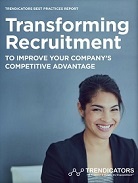

 Is your recruiting strategy delivering the results you want? Or are you juggling high turnover, disengaged employees and skyrocketing costs? The truth is that most companies face recruiting challenges to some degree, especially in today’s candidate-centric job climate. But sometimes the problem extends further than a tight job market and low unemployment rate. Here are five warning signs that it’s time to rethink your strategy.
Is your recruiting strategy delivering the results you want? Or are you juggling high turnover, disengaged employees and skyrocketing costs? The truth is that most companies face recruiting challenges to some degree, especially in today’s candidate-centric job climate. But sometimes the problem extends further than a tight job market and low unemployment rate. Here are five warning signs that it’s time to rethink your strategy.
1. HIGH TURNOVER RATES
Higher-than-average turnover rates can indicate problems with your company culture, engagement strategy or management style. But they may also mean you aren’t recruiting the right kinds of employees in the first place. High turnover sometimes indicates lack of understanding about what type of person will fit best in the role or an inability to attract the right kinds of candidates. Additional factors may include insufficient onboarding or training, lack of engagement processes, or unrealistic expectations.
What You Can Do: Use engagement surveys to pinpoint problems in your culture and reevaluate your recruitment process to identify potential mismatches between your cultural values and recruiting strategy. In addition to skills and credentials, look for personality, motivational drive and engagement potential in your new hires.
2. SHORT RETENTION TIMES
Short retention times often go hand-in-hand with high turnover. Like turnover, poor retention often results from unmet expectations, poor cultural fit and lack of engagement. While it’s not uncommon for employees to leave a company before their second work anniversary, it’s a red flag if new hires routinely exit during their first couple of months on the job.
What You Can Do: In today’s hiring environment, where candidates often have their pick of promising job opportunities, companies can keep workers on the payroll longer by intentionally working to engage new employees before their first day and helping them grow in their roles. Start with an intentional engagement strategy as well as a regular check-in with your employees about their satisfaction on the job.
3. LENGTHY HIRING PROCESSES
There are two problems with long hiring processes. First, candidates who are kept waiting too long may decide to accept another offer. Second, the people you do hire may already be disengaging, even before their first day on the job. Lengthy hiring processes can weaken your employer brand and reduce overall employee satisfaction.
What You Can Do: Assess your hiring process to pinpoint any steps that can be eliminated or scaled down. For example, you may be able to combine multiple stakeholder interviews into one panel interview. You may also be able to reduce the amount of time between steps or automate communication to keep candidates engaged and better informed throughout the process.
4. INSUFFICIENT TALENT PIPELINES
Reliable talent pipelines prevent drops in productivity associated with routine turnover, especially for volume hiring needs or specific hiring objectives. Insufficient pipelines can make it difficult to meet hiring objectives and may also result in higher recruiting costs.
What You Can Do: Rethink your strategy for identifying quality candidates from sources like your employee networks, career website, networking events and passive candidates. You may also benefit from working with an external recruiter to leverage extended candidate networks and data mining capabilities.
5. POOR QUALITY OF HIRE
Poor quality candidates aren’t necessarily incapable of getting the job done. They may simply be the wrong fit for your organization. In some cases they don’t have the necessary skills, or they may be recent college graduates without the experience needed to excel in the role. The end result, however, is the same. You spend more time and money on training than you anticipated, and the resulting output still fails to meet expectations.
What You Can Do: Reexamine your job requirements and be sure both hiring managers and recruiters are on the same page. You can also tie performance management metrics to your job requirements to create data-driven success benchmarks.
The Solution to Your Recruitment Challenges
The goal of strategic recruiting should be not only to fill open positions, but also to hire the best candidates for the role. The first step toward meeting that goal is to examine your recruitment strategy for inefficiencies. If you don’t have the time or resources to meet your recruiting goals internally, partnering with an external recruiter such as a recruitment process outsourcing firm, like Engage2Excel, can give you the leverage you need to develop reliable pipelines of quality candidates, reduce turnover and promote engagement across your organization.


